What’s The Deal With Alpha?
You’ve probably heard of the term “alpha” in your dog training journey. But this term might not mean what you think it does. Join Doug Poynter in this insightful episode as he dispels the myth about the dominant alpha. Most people think that the “alpha” is a domineering figure and dog owners often think that’s the role they should follow to get their canines under control. But this is simply false! It’s not about dominating at all; it’s all about leading. Punishment does not work! Doug cites studies done by Dr. L. David Mech, the person who coined the term “alpha,” and William Campbell, the expert in solving behavior problems with dogs. Listen in to learn why your training methods aren’t working and what you should do to fix it!
—
Listen to the podcast here
What’s The Deal With Alpha?
Welcome to episode number one of the Better (Dog) Behavior Now. My name is Doug Poynter, the owner of the business Better Dog Behavior Now in Richmond, Virginia. For many years, I have been helping people solve their canine behavior problems. I always tell folks that what I do is train people, and I help dogs because it has been my experience that I have yet to see a canine behavior problem that was truly a canine behavior problem. There’s always a human component. I’m training people while I’m training and helping dogs as well. I use behavior modification, and I will explain why some of that here in a second.
To let you know a little bit about my background, I started in Corporate America as a trainer. I was a sales trainer. Before Corporate America, I taught tennis for about ten years. I used to teach people to play tennis here locally, and then I moved into the corporate world and became a sales trainer. I have a pretty long experience of training people and relating to people while at the same time working with dogs.
That started several years ago when I had a behavior problem with my dog. My dog Ruger is the sweetest dog you ever saw in your life but Ruger had a thing where one night he growled at me over a bone. I’d given him a raw bone and walked by him. The growl that came out of him was nothing I had ever heard before. It sounded like he wanted to rip my face off, and I was completely stunned. This was my sweet dog. Everybody loved him. Where did this come from?
What I started to do was research. I’m a trainer. I said, “I will do some research and figure out how to fix this.” At the time, I didn’t think I was going to be teaching people how to do it but after I got into it and was very entranced by it, I said, “There are probably a lot of people who could use this help.” I ran into a guy named William Campbell. He’s no longer living. I talked to him on the phone and studied all of his stuff. I have spoken with his wife, Peggy. Great people. He is the Dean of solving behavior problems with dogs. He is the one who invented this stuff.
He wrote a textbook back in 1972 called Behavior Problems in Dogs. Not the most exciting reading on the planet but very valuable for a person like me, and I started to study his stuff. I realized I had caused my problem with my dog. As soon as I started making some changes, my dog went right back to being the nice sweet dog that he had been before, and this was what I found.
One of the things that I want to bring to you as I continue to do this show is that there was no punishment involved. There were no corrections involved but there was a big change in my dog’s behavior for the better once I understood what was going on. As a result of that, long ago, my vet was aware of all this, and he began to refer people to me and say, “Do you want to take on this behavior problem here?”
My very first client was a lady and a husband and a wife who had a beagle with separation anxiety so bad that they couldn’t even leave the room. He would start howling. They lived in an apartment complex. They had been given 30 days to fix it or they were going to be evicted. I never even met those folks in person. We talked over the telephone, gave them the information, and walked them through what they needed to do.
Three weeks after we met, I got an email from his wife and she said, “We were able to go to dinner last night for the first time in over six months, and he laid on the floor and slept. We know that because we ran the camcorder while we were gone and came home and watched the video.” That was so long ago. There were no cell phones like iPhones. None of that stuff. They had to set up a camcorder, run it, and come back and watch that video.
They said he slept the entire time that they were gone. That was my first big client, and I got many other clients after that from my vet. The other thing that propelled me into this is that there was a lady who ran a rescue organization here in Richmond, Virginia, who saw me working with a client’s dog at a boarding kennel. I was doing this part-time. I still had a corporate career. I was sales training people for Circuit City while I was doing this.
As I said, this was part-time. This lady saw me working with a client and her dog at a boarding kennel. The dog had been banished from the apartment that they lived in because he was so wild and crazy, running up and down the hallways. The lady that ran the boarding kennel said, “He was vicious. He tried to attack me,” which, of course, he did not.
Luke was an American Pit Bull Terrier. He had crazy yellow eyes. This lady thought he was trying to attack her, and he was not. He was the sweetest dog but was spooky looking. He was also very unruly. It didn’t take me long to help Laura. That was his owner’s name with Luke got his behavior under control and got him more orderly. This lady with the rescue organization saw me because she had her dogs at that boarding kennel and asked me if I would help her out.
What started all of this in terms of turning it into more of a business was creating a new adopter’s class for this rescue organization that we did every Friday night at 6:00 for several years. What she told me was that once the class started, the return rate to the rescue organization went down below 1%. That is the great secret. The evil secret of the rescue world is that many dogs get adopted and come right back to the shelter for the same reason they got sent to the shelter in the first place. That’s behavior problems.
This class was set up to help people solve or keep those behavior problems from happening. Whenever anyone had a problem once they owned the dogs, I would get hired to go out and solve those problems on the spot. That several years were very instrumental in me being able to get this whole thing started here in Richmond, Virginia, Better Dog Behavior Now.
The Myth Of Punishment
One of the problems that I had in working with folks was the idea that the way to fix a behavior problem is to correct it or punish it. In dog lingo, correction is usually synonymous with punishment. It was difficult, at first, to get people to understand that this was not the way to do it. Behavior modification was the way to do it.
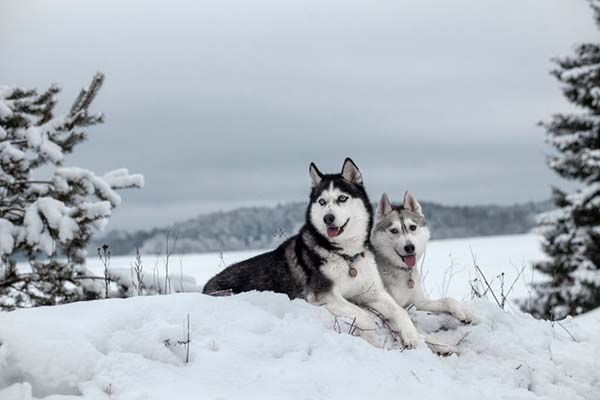
Alpha: In dog lingo, correction is usually synonymous with punishment. Behavior modification was the way to do it. The reason why people didn’t accept this or had a hard time accepting this was because there was the notion that we need to be alpha to our dogs.
The problem that I found and the reason why people didn’t accept this or had a hard time accepting this was because there was the notion that we need to be alpha to our dogs. The title of this show is Alpha Dominance Fact or Fiction. We are going to go through this, and I’m going to give you the low down on all of it. The biggest problem that I faced was everybody thinking that the dog’s behavior problem was the dog trying to be dominant.
Unless it was something like fear, the dog was trying to be pushy. The dog was trying to take over the “pack.” Where this came from is the idea of alpha dominance and the fact that we must be alpha to have control over our dogs and fix behavior problems. That’s a very popular notion. You can watch TV and see that come up on TV time and time again. Lots of stuff and methods in some of our training that is more old school. Even some of the traditional and balance training has to do with the underlying idea of maintaining dominance with our dogs.
Where does that come from? Once I was able to find some research on this understanding of where it came from and what the reality was, the thing that made me able to convince my folks to listen to what I was describing and to my behavioral methods so that we could solve the problem with their dog. I will tell you where it comes from. You probably know this. It comes from wolves. When I ask my clients, “Have you ever heard the term alpha?” They all go, “Yeah.” I go, “You know where it came from?” By far, the majority of them say, “It comes from wolves.” It comes from wolf packs and what we know of wolf packs and what we have known of wolf packs.
Your dog is descended from wolves. Science has pretty much come to that conclusion. The DNA in your dogs is 98.8% identical to the DNA in a wolf. Your dog can breed with a wolf. Dogs and wolves breed all the time. We know that our dogs evolve from wolves. The argument is how that happened. I won’t get into that now. We might make an episode out of that sometime in the future because it’s very interesting but it could take us a while. I don’t want to get sidetracked on that. That might be the argument.
The DNA in your dogs, 98.8% identical to the DNA in a wolf. Click To TweetSo far, the argument is not whether dogs came from wolves or not. Most people in the science world accept that as being the truth. Here’s what has happened with this alpha stuff. We have known that there’s an alpha male in a wolf pack who rules with an iron fist. There’s an alpha female as well. The alpha male maintains control and structure of the pack because he’s bigger, stronger, and better than all the other wolves in the pack.
When the other wolves try to take over or be dominant themselves, he’s able to slap them down, and that’s how they maintain control in a wolf pack. This is something that we have known over the years, and it has been the thing that has underpinned quite a bit of our training and “solving” behavior problems with our dogs. We have got to be dominant. They need to submit. Dominance and submission. You’ve heard that before. This comes from the idea of alpha in a wolf pack.
There was a textbook written many years ago called The Wolf: The Ecology and Behavior of an Endangered Species by Dr. David Mech at the University of Minnesota. This is not the most exciting reading on the planet unless you love textbooks. I have it here in my hands, and I’m flipping through the pages there of this book. Page 69 of the book is where Dr. Mech first mentions the term alpha. He categorizes all kinds of behavior in a wolf pack among the behaviors he categorizes as the dominance behavior.
Page 69 is where he first calls the lead male in the wolf pack alpha and the alpha female. I don’t know if Dr. Mech is the one who coined that term for wolves. The word alpha is a centuries-old word. The principle around wolves or the term alpha was not invented for that. Coining the lead male in a wolf pack could have been something that Dr. Mech did. I’m not sure about that.
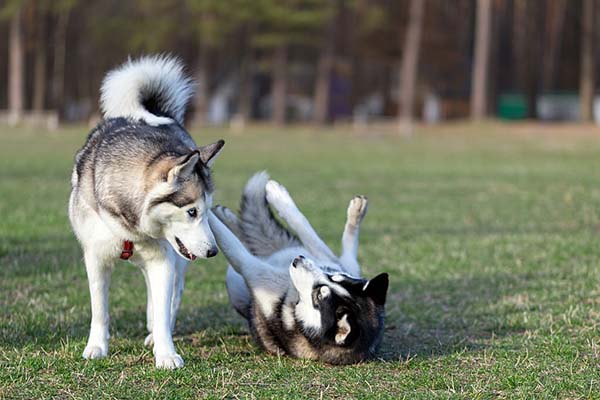
Alpha: That term “alpha” has come to signify what we need to be to our dogs to keep behavior problems from occurring.
That term has come to signify what we need to be to our dogs to keep behavior problems from occurring. We are especially told that when we are dealing with working dogs. German Shepherds, Belgian Malinois, Rottweilers, Doberman Pinschers, Boxers, American Pit Bull Terriers, Mastiff breeds, any of the Bully breeds, and Bulldog breeds. The herding breeds Border Collies, Australian Cattle Dogs, and Australian Shepherds.
If we are not dominant over these dogs, we are going to have some serious problems because what’s in a dog’s blood is to try to take over the pack, especially if the dog is a more dominant dog. You hear it, “He’s a dominant dog.” If we are not on top of that, that’s where we are going to have problems. This comes and is underpinned by the information about wolves.
This was what I had to overcome to try to teach my clients the best way to solve their behavior problems. Campbell, quite frankly, said, “Punishment doesn’t work.” Campbell, again, is the Dean of solving behavior problems, and this is the guy that I studied. My experience with the work that I did was that it was correct. When my dog growled at me, I tried to punish him. It didn’t help anything. When I changed the way I acted and did behavior modification, everything changed quickly.
Something was inconsistent here. Something is not computing, and it didn’t become clear until I began to read Dr. Mech’s studies. Here’s the deal. I’m telling you that alpha and dominance are not the way. I’m telling you, that’s wrong. I’m telling you that it is false. The title Alpha Dominance Fact or Fiction of this show, the answer is fiction.
The Idea of A Dominant Alpha Is Wrong
Alpha and dominance is not the way. That's wrong. It is false. So the title alpha dominance: fact or fiction? The answer is fiction. Click To TweetYou might say to me, “This is the very first show you’ve done. We don’t know who you are. I hope that won’t be true in a year,” but it’s probably true now for most of you reading this. “We don’t know who you are. We have seen it on TV. We have heard it from other trainers and have seen it down through the years that dominance and alpha are what we need. Why should we believe you when you say that it’s not true?”
Here’s the deal. It’s not me. It’s Dr. Mech himself. The man who is most responsible as the world’s foremost authority on wolves for coining this term or propagating this term, whether he coined it or not, again, I’m not sure. This textbook is where it began to be used on a regular basis. He’s the one who said it’s wrong.
Let me tell you what that’s all about, and then I’m going to tell you the information that’s right so we can begin to use that with our dogs because here’s my supposition. Tell me if I’m wrong. If wolves have evolved our dogs, our dogs came from wolves. If what we have known about wolves has been inaccurate, then what we have known about our dogs has been inaccurate as well.
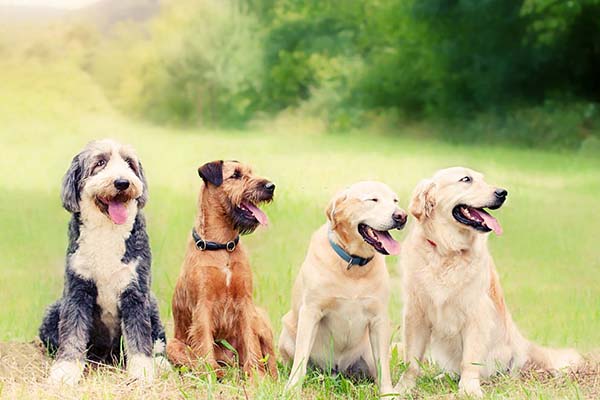
Alpha: Our dogs came from wolves. If what we’ve known about wolves has been inaccurate, then what we’ve known about our dogs has been inaccurate as well.
What I propose to do here is, first of all, why we got it wrong? Second of all, what’s right, and third of all, how can we apply that to our dogs? That’s what I do when I’m in my business. That’s what I do when I’m dealing with behavior problems. I don’t typically get hired to train a dog to do obedience. That’s pretty easy stuff. Most people do not want an obedience champion for a dog.
It takes a lot of skill to train a dog up to obedience champion level. That’s not what most people want. Most people want a dog that behaves. I get hired to make that happen. I’m going to tell you the stuff that works, and I’m going to tell you where it came from. The person who came out and said, “This alpha stuff is wrong,” is Dr. Mech himself, the guy who propagated it.
You can see Dr. Mech on YouTube. Listen to how long this has been out there, 2005. He put a video out on YouTube, and he didn’t beat around the bush and basically say, “I was wrong.” He said, “I was wrong. I’m one of the people who has been responsible for pushing this idea of alpha. The idea that an alpha male is an alpha male because he fights better is totally wrong because he’s bigger, stronger, and can smack the other wolves around is wrong.” I’m going to tell you why he said it’s wrong and what the right is, and we will move forward from that.
When all of this changes and then we are going to start talking about how this works for your dog. When we are done with this episode, I want you to be able to say, “He’s convinced me. The standard old school way of doing this is not the way to do it.” It doesn’t work. Wolves don’t do it. Why should we do this with our dogs?
Here’s what Dr. Mech said. First of all, things changed when he was able to do a study on the wolves of Ellesmere Island. Why was that so important? Ellesmere Island is in Canada. It’s above the Arctic Circle. At the time back in 1984, when Dr. Mech started this study, there were no people on Ellesmere Island. I’m given to understand that the only people on Ellesmere Island even now are scientists who are studying.
There are no people who are living on Ellesmere Island. Dr. Mech was able to do this study on the wolves of Ellesmere Island and study the wolves in their environment. Why is that important? He said, “We got this wrong for so many years about wolf behavior because we were never able to study wolves in their natural environment.”
I want you to understand something. Dr. Mech was not talking about our pet dogs. He was talking about wolves but again, our pet dogs evolved from wolves. Everybody wants to say, “If it works for wolves, it must work for our dogs.” I want to tell you what works for wolves so you can see what works for your dog.
Dr. Mech said that until his study, we were not able to ever study wolves in their natural environment. They had been so hunted by us that when the human scent was in the air, they were gone. We could study them from a great distance, by helicopter or airplane. If we wanted to get up close in personal with wolves, we had to study captive wolves. That’s where the information about alpha came from. Three studies in the ‘30s and ‘40s were on captive wolves.
There was a bigger and stronger male in this captive artificially created pack. Not wolves that were around each other in nature but had been forced into a pin. That’s a completely unnatural environment for a wolf. That’s like human beings being imprisoned. Wolves can travel 40 to 50 miles a day or more in search of food. They are always moving. To put them in a pin is a completely unnatural environment.
These studies were done on those wolves, and in those studies, there was a bigger and stronger male who was ruling with an iron fist. There were other wolves that were challenging him, and he would smack them down. The thought was that’s the way they are in real life in nature. That changed when Dr. Mech was able to do this study on the wolves of Ellesmere Island.
He went to Ellesmere Island from 1984 to 2000 every summer, sixteen summers. He saw some things that were different. From the information that I have gathered on Dr. Mech’s studies, I have pulled the things that I feel would work with our dogs, and they do. That’s what I want to give you. What Dr. Mech noticed was the first idea that there’s conflict in a wolf pack and that there’s an alpha male who’s got to slap everybody down.
The Pack As a Family Unit
The first thing that he noticed that dispelled that was this. A wolf pack is a family. The “alpha male and female” are mom and dad. The rest of the pack are their pups, who stay with the pack for 2 to 4 years before they run off, meet with another wolf, and start with their own pack, sometimes tagging onto the original pack. It’s a family unit.
As a matter of fact, Dr. Mech stopped calling them alpha. He calls them breeding male and female. One of the things that he says in the video on YouTube is this very little structure in a wolf pack or a wild dog pack which completely blows the whole theory out of the big strong male keeping order in the pack. There’s very little structure.
The alpha male and female, I call them alpha because breeding male and female is too many syllables for me but mom and dad are what I’m saying. They are the family. That’s one of the reasons why there’s not this fighting and trying to take over the pack. When people tell you your dog is trying to be dominant, it’s not in your dog’s blood to try to take over your human pack. You don’t even have a pack but it’s not in their blood to do it. What’s in their blood is cooperation.
Your dog is essentially a collaborative being. Your dog needs a job. Your dog needs to cooperate and collaborate with you and you with your dog. Click To TweetThat’s one of the things that Dr. Mech talks about is the fact that each wolf has a job on the hunt, and they can execute that job flawlessly. That doesn’t mean they always get their prey but they have to work together. A single wolf could not bring down a 1,200-pound moose by itself. They can’t do it, so they have to work together to be able to survive. The main activity of wolves is eating and hunting. In order to survive, they have to cooperate.
The first thing I want you to keep in mind is that your dog is essentially a collaborative being. Your dog needs a job. Your dog needs to cooperate and collaborate with you and you with your dog. Does your dog need to be a bomb-sniffing, arson, police or tracking dog? No. That’s not necessarily what having a job means. I’m going to show you a principle from Campbell. We are going to mold these two things together. I’m going to show you how you can turn everyday real life with your dog into a job.
One of the things that Dr. Mech noticed was cooperation, collaboration, and working together to acquire wolf gold, food, and hunting. Number 1) The reason why there’s no conflict in the wolf pack is that they are family. Number 2) The reason why there’s no conflict is that they cooperate with each other. They have got to work together on the hunt.
There’s something else here that is very interesting, and this is what I have pulled out of this. Dr. Mech is not talking about dog behaviors. He’s talking about wolf behavior but I have pulled this out and it seems to work very well. Here’s what you’ve got to understand about people who do what I do. We are always studying. The ones of us who do well at this are the ones that work hard at this. We are studying.
Anybody who tells you they know what’s going on in every way, shape or form with every dog runs like you stole something because nothing works with every dog. You’ve got to be open. You’ve got to understand the principles and study. That’s what I have been doing here with this information with Dr. Mech. What I’m about to tell you seems to work well with gaining great behavior with your dog, and I’m going to give you a little wolf reference to it.
What Dr. Mech says is that, “With the important activities in the wolf pack, mom and dad, alpha breeding male and female or whatever you want to call them, initiate activity.” They don’t tend to follow activity. I will give you an example. If you and I were to see each other, and I was to extend my hand to shake hands with you, and you extended your hand back, I would be leading that. You would be following but if I extended my hand and you didn’t extend your hand back, you would be leading that.
Where humans are concerned, that’s rude but where canines are concerned, if you are the leader, if you are mom or dad, that’s normal. One of the things that he noticed is that when the breeding male and female alphas come back to the pack and the other wolves come running up to greet them. The other wolves are trying to initiate the activity of affection. The alphas, mom and dad, stand and take the adulation. They don’t respond back. They very nonchalantly take the adulation.
When I look at that, I go, “They have to not respond because if they respond, they are following.” The lower wolves are attempting to initiate an activity of affection. If you come to me and you lick me around the face, which is what they do. The lower wolves are up greeting them. They are all wiggling, happy to see them. Yipping or licking around the face in the mouth. These are activities that say, “You are above us. You are our leaders.”
If I’m the upper wolf and I respond back to that, then I followed you. That’s why they don’t, because they are running the show. There’s never any lack of affection for mom and dad in a wolf pack. Other activities that lead wolves initiate, it’s time to hunt. When it’s time to go hunt, the alpha male goes. Everybody has to follow him. He doesn’t go check to see if everybody is ready. He takes off, and they follow. Why? He’s leading.
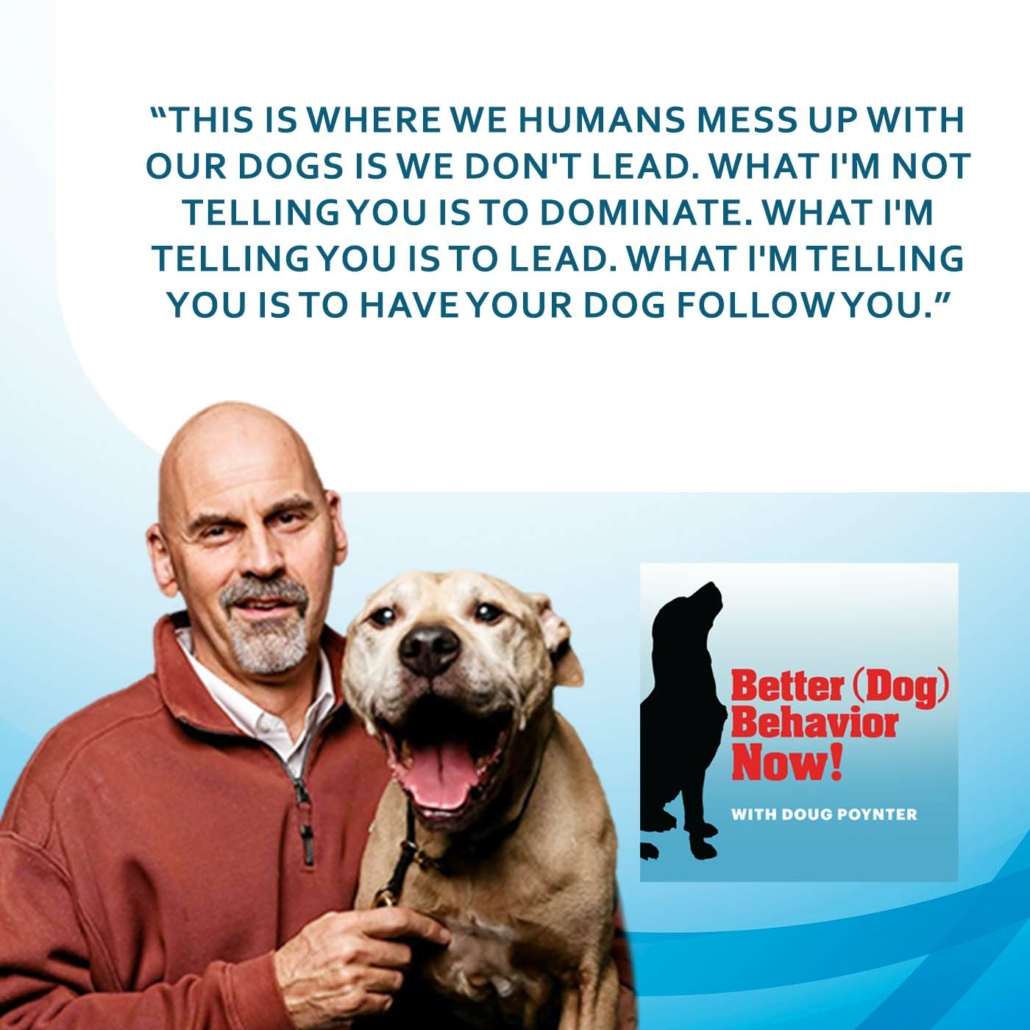
Why You Should Lead Not Dominate
This is where we humans mess up with our dogs, we don’t lead. I want you to understand something. What I’m not telling you is to dominate. What I’m telling you is to lead. What I’m telling you is to have your dog follow you. That is step number one to creating better behavior with your dog. Let me show you how we can mess that up. One of the things that sometimes happens when your dog wants love and affection, and there’s no reason you can’t give your dog love and affection but one of the things that will happen.
Sometimes your dog comes up and takes her nose and nudges your hand with her nose. Puts her nose under your hand and tries to nudge it to get you to pet her. Paw at you or come up and drop a toy in front of you. Come up and adopt the play stance in front of you. Chest down, butt up, tail wagging, barks or yips because they need to go outside.
These are not attempts to dominate, take over or be a leader. They are not. What they are is their request for affection in dog language, “You are my leader. Please give me love, attention, and affection.” That’s dog language. In human language, we think that’s cute. We pet the dog. We throw the toy at the dog or take the dog out. We give the dog what it wants. It’s fun, and our dog is cute. There’s only one problem, that is, we followed in that transaction. We did not lead that transaction. We followed, and this has been my experience over many years.
When people follow their dogs on a regular basis, then the dog can listen to them if he wants to. If he doesn’t want to listen, he doesn’t have to. Why? It’s because he’s leading the transactions. Please understand me. It’s not like your dog tried to take over. He did not. He was looking for love, affection, and attention but what we did was put him in the driver’s seat of the car. “Go ahead. You drive.” What then happens is when he behaves the way a dog who’s in the driver’s seat behaves, doesn’t listen and does what he wants to do whenever he wants to do it, we then punish him and correct him.
I always use this analogy. It’s like when you were a kid, if your parents said, “Let’s go out and drive. You are sixteen. Let me take you out and teach you how to drive.” You put the keys in your kid’s hand, and the kid goes and sits in the driver’s seat and puts the key in the ignition, and you pop him for putting the key in the ignition. “What are you doing?” “You put me in the driver’s seat. Don’t you want me to drive?”
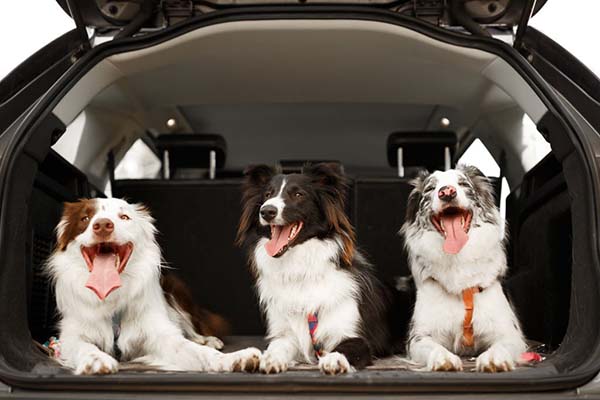
Alpha: We are correcting and we’re punishing a dog that 99% of the time we have placed in the driver’s seat of the car.
Can you see how this would drive a dog crazy? Create neurotic behavior on the part of a dog. We are correcting and punishing a dog that, 99% of the time, we have placed in the driver’s seat of the car. This is in dog behavior to cooperate and work together, and there are certain signs that show dogs who are running the show and not running the show. Please don’t confuse that with dominance. That’s not it.
Dr. Mech said that in one of his studies, if I remember correctly, the language was over the sixteen summers he was on Ellesmere Island. “You hardly ever saw a dominant behavior.” The lower wolves are always squabbling with each other over who gets food first but the leaders don’t get involved in all of that. It’s a very unstructured environment led by animals who lead, not follow.
What we do with our dogs in correcting behavior and punishing behavior is way over the top. I got a client with a dog that had been into protection training. He was a little too nervy about that. He’s a German Shepherd. He was considered very dominant. He was sent to a board and train. When he came out of the crate, he ran at the trainer and tried to attack her. They said, “We are not going to take this. Will you take it?” I said, “Sure.”
Jeff, the guy who owned this dog, I went to his house. I said, “Bring him out on a leash. Do not yell at him. Do not talk to him when he goes off. Stand there with him on the leash.” I showed him how to operate the leash so that it didn’t aggravate the dog. Pulling the leash tight aggravates the dog. You have to have a good grip but you are not pulling it tight.
When he brought the dog out, the dog dragged him down the steps trying to get to me. He went off up on his hind legs barking. You’ve all heard a German Shepherd lose it, multiply that by 2 or 3, and that’s what you had here. It took me 45 minutes. Not once did we correct anything. I waited for him to calm and then I rewarded him.
I will tell you something. In the last session I did with him, we walked him through Bass Pro Shops. People were walking up to him and petting him. He was wagging his tail. He was a calm, nice dog, not one correction but we did a lot of behavior modification. I taught Jeff and his family how to lead and get the dog to follow him.
Dogs love this. They love being part of a team. I’m going to tell you how to do that, and then we are going to wrap this thing up. What it is, we are going to add a Campbell principle to this. It’s going to immediately get your dog working and also following you. If you have a dog that seems to be pushy and dominant. I want you to try this and see what happens. When your dog comes to you and asks for or demands attention, if he’s done this for a while, he might seem demanding.
When that happens, instead of giving him the love and affection that he wants right away, I want you to ask him to do some work for it first. What could that be? Ask him to sit, lie down or come to you. This is Campbell’s earn your praise program. A lot of people try to take things in this business and appropriate it for their own, so some people have called this, “Nothing in life is free.” I like that name, but Campbell is the one who invented this, Earn Your Praise.
Some people call it Earn to Learn. Some people call it deference. It doesn’t matter what you call it. Ask your dog to do some work for the love and affection that you want to give him anyway. He comes up and nudges your hand with his nose. Ask him to sit. If he sits, then you can pet him. If he doesn’t sit, ignore him for an hour or so.
Ask your dog to do some work for the love and affection that you wanted to give him anyway. Click To TweetDon’t look at him, talk to him or touch him. Come back later, ask him to sit or ask him to come to you, and if he does, then you can give him some love and affection. That will begin to change the tie. Am I saying this is going to fix all your behavior problems? I’m not saying that at all but it sets the foundation so that fixing them is a much easier prospect.
I hope this has been helpful for you. This has been our first session. The show is brought to you by Better Dog Behavior Now, www.BetterDogBehaviorNow.com. I will be creating another one here for you and a little bit, and we will continue down this road to creating better behavior in your dog and on the parts of human owners to help facilitate that. Thanks a lot.
Important Links
- Behavior Problems in Dogs
- The Wolf: The Ecology and Behavior of an Endangered Species
- YouTube – “Alpha” Wolf?
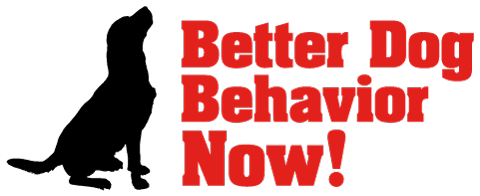
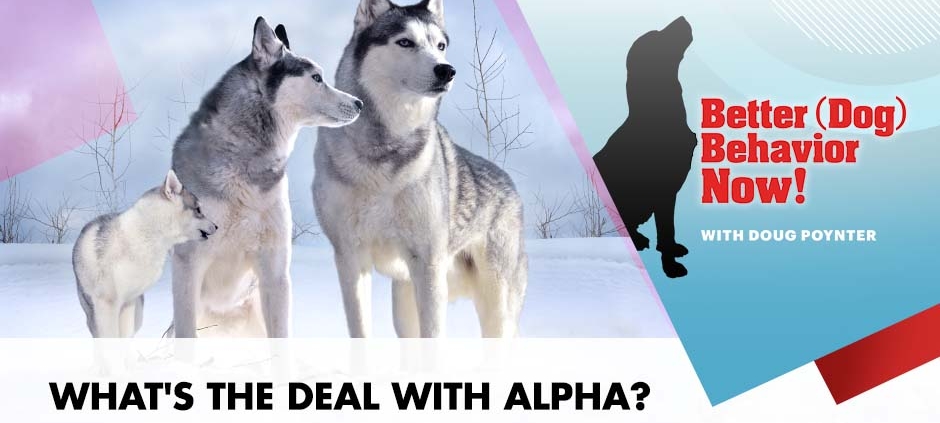


Leave a Reply
Want to join the discussion?Feel free to contribute!
You must log in to post a comment.